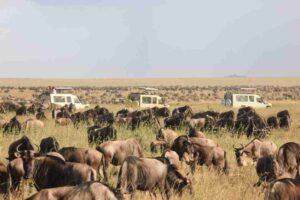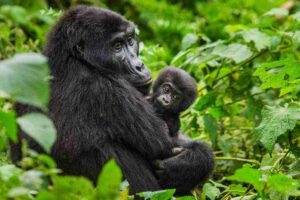| Name of the facility | Ashnil Aruba |
|---|---|
| Certification Achieved | Bronze |
| Year opened | 2008 |
| Tourism region | Tsavo/Amboseli |
| County | Taita–Taveta |
| Address | 10557, 00100Nairobi ‐ Kenya. Map It |
| Telephone/Mobile | +254-717 612499 |
| [email protected] | |
| Website | https://ashnilhotels.com/aruba/ |
| Facility Notes | Ashnil Aruba is located within Tsavo East National Park on the banks of Aruba Dam. It was opened in 2008 owned and operated by Ashnil Hotels Limited. The lodge has 46 rooms and six tents, with a total bed capacity of 100 guests. It employs a total work force of 48 employees. Tsavo East National Parks covers approximately a total of 11,747 km2. It is one of Kenya’s oldest and largest National Parks managed by Kenya Wildlife Service. Its landscape and proximity to the coast make it a popular safari destination. The park is accredited for its rich biodiversity. Vegetation cover includes bushy grassland and open plains alternate with semi-arid acacia scrub and woodlands, the Galana river banks give rise to lush vegetation. There is a wide variety of wildlife to be seen including lions, leopards, cheetahs, zebras, giraffes, serval cats, antelopes, kongoni, lesser kudu, Oryx, klipspringer, impala, stripped hyena, gazelles, buffalos and elephants. The park is a bird haven with over 500 bird species recorded in the area, including ostrich and some migratory kestrels, and buzzards |
| Energy management | The lodge is mainly powered by four diesel powered generators which produce enough power for lighting, water heating and running the electrical appliances. They are rationed and run at alternative times depending on power load needed and their fuel usage recorded for monitoring purposes. The driver guides and staff quarters have been fitted with solar water heaters. To promote energy conservation, approximately 50% of the facility is fitted with energy saving bulbs and light emitting diodes (LED) .The guest tents are fixed with main switches and the night guards sensitized to switch off unnecessary lights. In addition, Liquefied petroleum gas (LPG) is used for guests and staff cooking and the employees are sensitized on energy conservation through departmental briefings. Visitors are sensitized on conservation upon arrival. |
| Environmental management | The lodge has environmental management plans for water, energy and waste; an emergency response and an evacuation plan is also available. |
| Chemical use | The camp uses biodegradable bathroom amenities in the guest rooms supplied by Cinnabar Green.Gas is purchased in two tonne cylinders which are well serviced for safety purposes. Diesel is stored in two underground reservoirs of 10,000 and 12,000 litres while the petrol is stored in a 12,000 litre underground reservoir. The reservoir system is fixed with a fuelling pump. The chemical uptake for the laundry machines is automated which ensures efficiency on chemical usage. Material safety data sheet records for the chemicals used within the facility are available. |
| Conservation Criteria | |
| Community Criteria | |
| Solid waste management | Waste separation is conducted at source in clearly labelled, colour coded bins after which plastics, metallic waste and glass are put in a waste holding section awaiting disposal to recycling firms. Organic waste is composted in a tightly covered pit, reinforced with a metallic covering to keep off scavengers. |
| Water management | Water within the facility is sourced from a borehole, which is stored in 2 reservoirs of 24,000 litres. This water is then pumped in an overhead tank of 24,000 litres and then flows via gravity to the entire premises. Water is metered at source and recorded daily for monitoring purposes while water efficient equipment including low shower filter heads, dual cistern toilets and lift taps are installed within the facility to further conserve water. Regular maintenance and repairs are done to monitor faults or water leakages. The guests are given “towel talks” in their tents which encourage them to re-use their towels and the employees sensitized on water conservation during departmental meetings and briefings |
| Visitor communication & education | Visitors are briefed upon arrival on the environmental values of the lodge. |
| Pollution | Lighting at night within the facility is done through the use of low light emitting bulbs which reduce on light pollution. |
| Environmental conservation | Ashnil Aruba blends in with the surroundings. The guest rooms are made of concrete, with brown roofing ceramic tiles. The lodge further promotes conservation by supporting the Kenya Wildlife Service (KWS) through wildlife monitoring specifically by reporting injured wildlife and planting indigenous trees using seedlings acquired from the Kenya Forest Service (KFS). Approximately 500 seedlings have been planted. In addition, the facility has an Environmental Committee that meets twice a week that carries out weekly environmental clean ups and sensitizations within the lodge premises. |
| Waste water management | Grey water from the guest and staff kitchen flows through a grease trap to filter out the oils and grease before draining into a soak pit, while that from the laundry, guestrooms and staff quarters is managed via soak pits. Black water from both the guest and staff quarters is managed through septic tanks and EMI bio-enzyme added to enhance sludge digestion. The effluent later drains into soak pits fixed with radial arms. The swimming pool is cleaned via scrubbing and backwashing and the chemical uptake well monitored through PH readings. |
| Purchasing and supplies | Fruits and vegetables are packed in reusable crates to reduce on general waste produced while meat and dairy products are stored in cool boxes. |
| Employment and remuneration/staff welfare | Employees have a staff welfare committee which handles and addresses staff issues. It meets on monthly basis |
| Staff education, communication and awareness training | The staff receive information on health and safety trough notice boards which also contain the staff memos. |
| Cultural preservation and promotion/protection of local sites | The lodge engages a local dance group, Mwazindika dancers, to perform for guests. They are paid on a contract basis and offered transport services. |
| Benefits to local community/community empowerment | The facility hires more than 60% of its permanent employees from the local area and also allocates its casual work to the locals. The employees are provided with health care, uniform, accommodation facilities and basic amenities such as food. Purchases are made locally where possible and a community engagement plan is in place with initiatives that include: • Supporting the Kenya Wildlife Service in the medical care of rangers and offering them transport services • Conservation activities through partnerships with KWS and KFS through tree planting initiatives in the park • Promoting education in the area in partnership with Service Age Group Association (SAGA) and providing rain water harvesting tanks at Kilele school, fencing the school and building them a classroom • Giving donations to support Sagala orphanage in Voi |
| Cultural Criteria | |
| Health and safety | An emergency plan is in place which has clearly spelt out procedures on fire safety, medical care and evaluation. A health inspection has been conducted and the lodge issued with a health inspection certificate from the ministry of health. In addition it’s linked to AMREF flying doctors services for emergency purposes and has a 24hrs clinical officer on duty for staff and guests medical care. The referrals are made to Moi Hospital Voi. For further safety in the facility, there’s a fully stocked first aid kit available at the main departments together with medical supplies and the staff members trained on first aid skills. The lodge also has a team of staff trained on occupational health and safety which meets on a monthly basis and have minutes for their meetings available for verification. The lodge has placed firefighting equipment including fire extinguishers, fire electric alarm and a fire blanket in the kitchen strategically within the facility. Further, safety and precautionary signage such as ‘no smoking’ and ‘highly flammable’ are strategically fixed in areas including the generator room and fuel storage area. In addition to this, the staff are provided with protective gear such as boots, uniform, gloves and aprons and a clearly and conspicuously marked fire assembly point is available within the lodge. A fire alarm has also been fixed. |
| Child labor, abuse and human rights | Minimum employment age is 18years |
| Business Practises Criteria | |
| Entry Date | 12th March 2018 |













